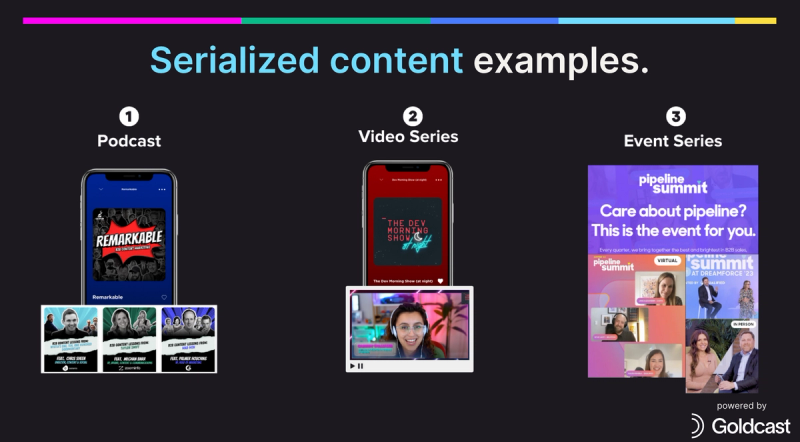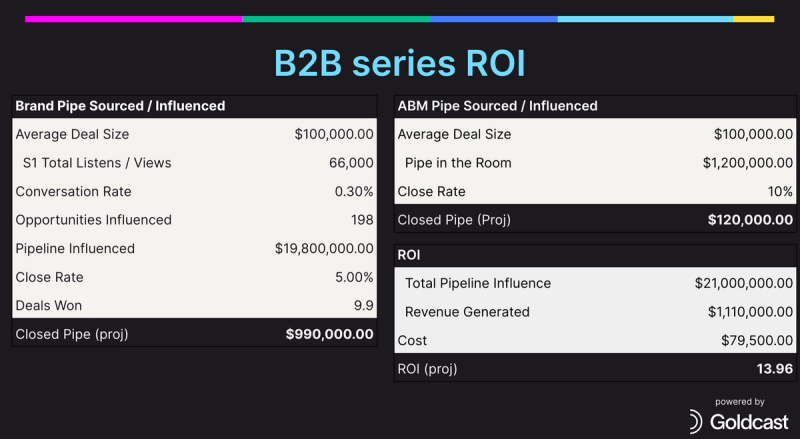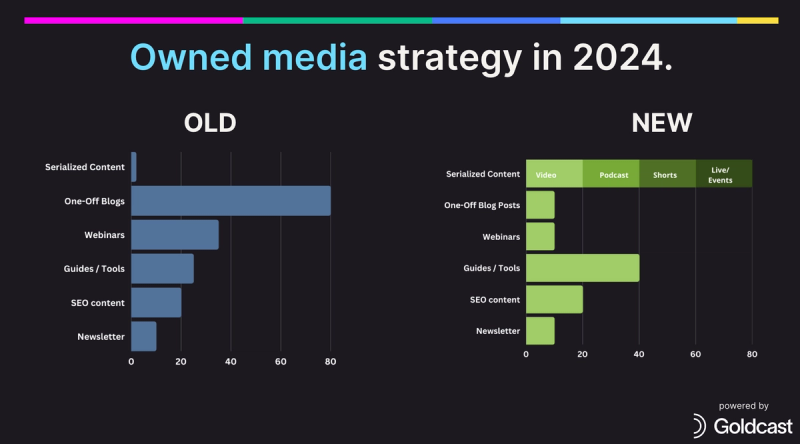Build Brand, Grow an Audience, and Increase Revenue with an Event Series

Table of Contents
- "Serialized content is eating the world"
- Series connect you with buyers well ahead of the purchase decision
- Find the smallest viable audience possible
- What does B2B serialized content look like?
- 5 things B2B series need to have
- Series can lead to major ROI
- A case study: Qualified's "Pipeline Visionaries"
- Out with the old and in with the new!
- Serialized content frequently asked questions (FAQs)
Maximize Your Marketing ROI
Join 10,000 other marketers already getting the best tips on running engaging events that boost pipeline and create raving fans.
What are your 2024 goals? If any of them include building your brand, growing your audience, or bringing in more money, you might want to start a digital event series!
We kicked off our four-part Series Masterclass with a banger of a lineup, featuring our Associate Director of Content and Campaigns, Lindsay McGuire—who also runs one of our own event series, Donuts and Demand!
Lindsay talked with Ian Faison, CEO of Caspian Studios, and Maura Rivera, CMO at Qualified. Caspian produces about 65 shows for primarily B2B tech companies, and most of those shows are video series or podcast series. Qualified, on the other hand, is a pipeline generation platform for B2B company websites.
These two work closely together to pull off an exciting and successful event series strategy for the Qualified team, and we wanted to dig deeper into how they make it happen.
Read on to learn:
- "Serialized content is eating the world"
- Series connect you with buyers well ahead of the purchase decision
- Find the smallest viable audience possible
- What does B2B serialized content look like?
- 5 things B2B series need to have
- Series can lead to major ROI
- A case study: Qualified's Pipeline Visionaries
- Out with the old and in with the new!
- Serialized content FAQs
📺 Missed the event and want to watch in full? Check it out now here.
"Serialized content is eating the world"
Ian recently released an eBook on serialized content called The Serialized Content Framework, and the book opens with a play on Marc Andreessen's famous quote, "Software is eating the world"—but this time, it's serialized content!
When Ian studied the last decade of consumer behavior and marketing efforts, he found that there's been a steady evolution toward building series and binge-worthy content.
If you look at the entertainment industry, they've been long aware of this trend. Bingeable content awaits us on almost every platform, from Netflix to Apple Podcasts, and even at the movie theater, with franchises like Marvel or DC. "Everyone is obsessed with series," stated Ian.
People love series, and they tell people all about their favorite ones. Series are often the things that go viral, inspiring memes and trendy sayings. People develop relationships with series (and hosts of series) that is totally different than one-off content; they get the chance to know and love the people involved more than they could during 1-2 hours of a movie.

Series connect you with buyers well ahead of the purchase decision
So, what does this mean for B2B companies? Well, we know that only 5% of your audience is probably ready to buy at any given time. We also know that decisions are being made in a variety of different ways, buying committees are getting bigger, and sales cycles are longer.
"If buyer behavior has changed, then you need to figure out a strategy that is going to get them upstream engaged in a way that's valuable, ongoing, and repeatable," explained Ian.
This means that you need to connect with people long before they're ready to make a purchasing decision. You want to be the brand that's a no-brainer choice for them, come Decision Day, because you've been in front of them this whole time. Series do that.
Find the smallest viable audience possible
Ian had a big realization while writing his book: There are riches to be found in niches, and oftentimes, that means the smallest viable niche you can get down to. Then, you want to engage with them with serialized, persona-based content.

As you can see, if you think about how big of a "splash" your content can make, if you've got a huge potential audience (say, CEOs of tech companies), your content is likely not going to make a huge impact on the group as a whole.
However, the smaller your niche becomes, the more likely it is that those people do hang out, mingle, and share information often, which means your content can make a big impression!
What does B2B serialized content look like?
Traditional serialized content might be a podcast, a video series, an event series like this, or even a written series. Non-traditional might look like fiction, documentaries, music, comic books, or something totally different!
No matter which route you go, you want your series to be multi-channel and multi-format so it can reach the maximum number of people.

You want to strike a good balance between education and entertaining—"edutainment," if you will. You can see in the graph above that much existing B2B content falls squarely in the educational and not-so-entertaining space, from white papers to blog posts covering product features.
Here are some examples from Caspian's work:

First, you've got the Remarkable podcast, which covers marketing lessons from Hollywood and beyond. Then there's a video series called The Dev Morning Show at Night with Cassidy Williams, who is a creator and developer with a big following. And, finally, an ongoing series, Pipeline Summit, which is a Qualified show offering the best tips on how to generate more pipeline.
5 things B2B series need to have
"Event series impact the whole funnel in a way that something like paid ads could not do," stated Ian.
Ian shared five things that every B2B series needs to have:
- Peer-led: Co-create with your ideal customer persona! The series should be led by people you consider peers; that will make it a lot more effective, interesting, and relevant to the intended audience.
- Edutainment: We just talked about this one; it's critical to offer some levity to educational content and try to make it funny, uplifting, and engaging.
- Multi-channel, multi-format: Be sure to distribute your content across channels, and create it in different formats, like longform video, shortform video, longform audio, blogs, etc. People like to consume content in all different ways, so try to have it available for them to do so, no matter their preferences.
- Persona driven: Always pick the persona that is the most valuable to you. This will help drive your content strategy around the series. As Ian notes, "If you can't look at the show and in five seconds, know exactly who it's for and the value you're getting, you screwed up."
- Serialized: Build consistency and familiarity through your series. It's fine for content to stand alone so that people can tune in to different episodes and still know what's going on; the main goal is that you're making constant impressions on people, and they start to know what to expect from you.
As you build and promote your series, you should also think about building people as media channels. The LinkedIn algorithm does not boost companies' posts because it wants people to engage, so having your host, guests, and other talent be the ones to spread the word about the series will go a lot farther.
Series can lead to major ROI
"I would not have anticipated how much a series would help us from a pipeline generation, deal acceleration, ACV perspective," explained Maura Rivera, CMO at Qualified.
The beauty of serialized content is that it can touch every single one of your business goals, whether you're looking to build relationships, drive pipeline, or put your executives more in the spotlight. How many other types of content can do that?!
Check out this ROI info Ian shared:

Series have the potential to drive ROI in big ways. Ian's seen companies pull in $900K deals with just one sourced guest!

A case study: Qualified's "Pipeline Visionaries"
Maura still remembers meeting with Ian pre-COVID and dreaming up a show concept that could help Qualified look like a bigger industry player.
Through conversations with their industry peers, Maura and Ian realized that people really wanted to know how CMOs are spending their money. In order to tell that story, however, they'd need to know a lot of other things first, about strategy and GTM.
That's how Pipeline Visionaries, originally called Demand Gen Visionaries, was born. (As good marketers do, Maura's team discovered through A/B testing that "pipeline" outperformed any other word, and they changed the name.)
Episodes of Pipeline Visionaries drop weekly and are shared by the Qualified team as well as guests, and they're hosted on YouTube. Once you have a show like this, it kind of becomes its own machine. Here’s just a few ways a series can help your build brand, grow an audience, and increase revenue:
- You can invite guests on who your ICP follow
- Use it to promote upcoming events
- Accelerate sales conversations with ideal accounts
- Promote it across all channels as an entry-point to your brand
- Give sales an always-on content channel to invite new leads to
After each show, the team creates microcontent, especially around their "uncuttable budget item" segment, which has proven to be a super popular part of the series, and then they post that across social. They've even spliced together clips of just that microcontent to create supercut episodes!
Out with the old and in with the new!
The days of one-off webinars and boring newsletters are quickly coming to an end. In order to stay competitive in today's market, you'll need to dive into serialized content and produce bingeable, shareable series that people can't wait to tune into.

Don't forget to watch the full episode to hear straight from Ian and Maura about serialized content and how they built successful series at Qualified and other companies!

Serialized content frequently asked questions (FAQs)
Our audience members had a LOT of questions around how to run a series and create serialized content. Here's just a few of the questions we answered live during the event.
Q: How do you manage the workload behind an entire series when you have a small team?
A: When Maura began Pipeline Visionaries, she was the only person on the team. She advocates for partnering with experts whenever possible. Perhaps that's a podcast production partner who can help take some of the work off your plate, as it was in her case.
You can also start with a small lineup of, say, 12 episodes and spread them out over half the year and go from there. That will be more manageable than trying to launch multiple series at the same time and becoming overwhelmed.
Q: How do you efficiently repurpose content from your series?
A: You definitely want to get all the runway you can out of each episode of your series. Check out Goldcast's Content Lab, which can help you cut up clips from your show, as well as notable quotes, synopses to use as you draft blog posts, and more—all in just minutes!
Q: What's the optimal cadence to release episodes within a series?
A: This one depends on your objectives, but the most important thing is to be consistent. As a general rule of thumb for a podcast, you could aim for every other week and do a 12-episode series over the course of six months.
If you can get to weekly, that typically performs better, but do what you can with your current resources. You can also create a couple episodes ahead of time and have them in your library so that when you do promote your pilot, there's more content for people to browse.
You also don't have to do hour-long episodes. You might do 3-minute, 5-minute, 10-minute shows. Think about how much time your listener has and the message you need to get across, and design your show accordingly.
For event series, we've found that our audience likes to attend a live event once a month on the same day of the month each time. Your mileage may vary!
Transform Your Video Marketing with AI
Stay In Touch
Platform
Resources
© 2026 Copyright Goldcast, Inc. All rights reserved.





 Upcoming Events
Upcoming Events Event Series
Event Series On-Demand Events
On-Demand Events

